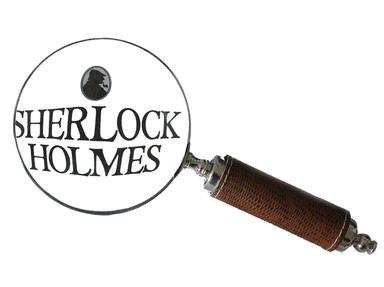Quiz Answer Key and Fun Facts
1. When Holmes was summoned to investigate the death of Enoch J. Drebber, Holmes easily identified the man who delivered the letter as a retired sergeant and even named the branch of the military the man had belonged to. Watson took this to be "brag and bounce" until he was able to question the man himself, who verified every word Holmes had spoken. What corps had the messenger done service in?
2. True or False: When Stanley Hopkins called on Holmes to investigate the murder of sir Eustace Brackenstall at Abbey Grange, his letter was extremely vague. Holmes, however, knew it was a serious matter from the wording of the letter and the agitation Hopkins had shown when writing. He could also tell Watson that they were moving in high society, based on an estimate of how long it would have taken Hopkins to be alerted at Scotland Yard, go out, and send the letter to Holmes.
3. The letter Holmes received from Lord St. Simon did not tell Holmes very much, as he was not familiar with the painful event of St. Simon's marriage and the disappearance of the bride. But Holmes immediately noticed that his Lordship had experienced another, much more trivial, misfortune that very morning. What kind of accident was this?
4. During "The Greek Interpreter" Sherlock and Mycroft Holmes engaged in a little brotherly competition to see who could observe and deduce the most about an unknown man they saw from the window of the Diogenes club. Mycroft won when he stated what point?
5. Dr. Watson was always Holmes' easiest subject to glean information from, as he does several times in the Canon. For instance, in "The Adventure of the Crooked Man" Holmes could tell from Watson's very clean boots that he had been busy in his medical practice lately.
6. In "The Hound of the Baskervilles", Dr. Mortimer left his walking stick at the rooms in 221b. Holmes could see from the stick that the doctor had a small dog, by the tooth marks the dog had made in it. But how could Holmes know that the dog was a curly-haired spaniel?
7. One October evening in 1881, Holmes and Watson went on a walk through London to get some fresh air. When they returned to Baker Street, they found a carriage waiting outside no. 221 B, one which Holmes could tell belonged to a doctor - a general practitioner who had only recently acquired his own practice. And true enough, the owner turned out to be Dr. Percy Trevelyan, who came to present the case of his resident patient to Holmes. Holmes also immediately made a second observation about Dr. Trevelyan, of what nature?
8. Mr. James Dodd came to Holmes with a very strange case, known as "The Adventure of the Blanched Soldier". Holmes gave him a small display of his deduction powers, something that always impressed his clients and gave them a feeling of being in capable hands. For his first remark, Holmes concluded that Dodd had recently been a soldier in South Africa, both on the basis of his tan and what other feature?
9. Finish this quote from "The Solitary Cyclist": "I nearly fell into the error of supposing that you were typewriting. Of course, it is obvious that it is _____. You observe the spatulate finger-end, Watson, which is common to both professions?"
10. And finally, the most famous of them all: When Sherlock Holmes and Dr. Watson were first introduced to one another, the very first sentence spoken by Holmes was "How are you? You have been in _________, I perceive". Which country had Watson recently arrived from?
Source: Author
Twotallgnome
This quiz was reviewed by FunTrivia editor
agony before going online.
Any errors found in FunTrivia content are routinely corrected through our feedback system.
